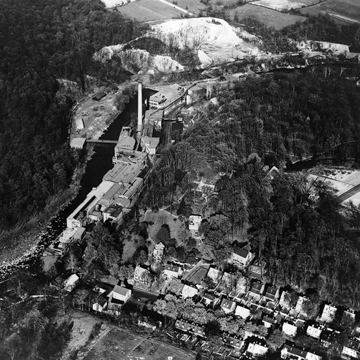English-born Quaker Joseph Bancroft was trained in cotton weaving in Lancashire. He bought a grist mill here in 1831, at a time when grain milling was on the decline. He switched it over to cloth making, specializing in glazing fabric for awnings, tents, and especially window shades. In 1859–1860, Bancroft added bleaching and dyeing equipment. By the 1880s, the firm was the largest textile finisher in the nation, with its brick and stone mills sprawling along the riverbank. Bancroft built worker housing in Rockford Village on Rockford and Ivy roads. His son donated land uphill from the mills for Rockford Park in 1889 and 1895 (see Kentmere Parkway and Rockford Park). As late as the 1940s, this was called the largest cotton dyeing and finishing plant in the world, with a soaring, 250-foot yellow-brick smokestack (by Heinecke, a New York firm, 1911). Bancroft Mills was bought out in 1961 and later closed. Only part of the extensive original complex survives, and, in 2007, a developer proposed demolishing most of the toxics-laced remainder and building condominiums.
You are here
Bancroft Mills
If SAH Archipedia has been useful to you, please consider supporting it.
SAH Archipedia tells the story of the United States through its buildings, landscapes, and cities. This freely available resource empowers the public with authoritative knowledge that deepens their understanding and appreciation of the built environment. But the Society of Architectural Historians, which created SAH Archipedia with University of Virginia Press, needs your support to maintain the high-caliber research, writing, photography, cartography, editing, design, and programming that make SAH Archipedia a trusted online resource available to all who value the history of place, heritage tourism, and learning.









